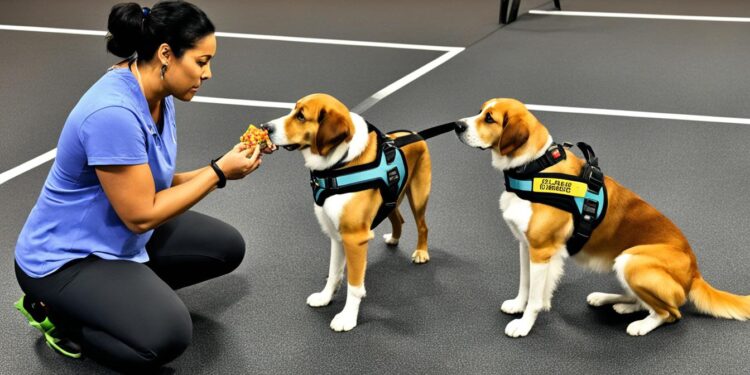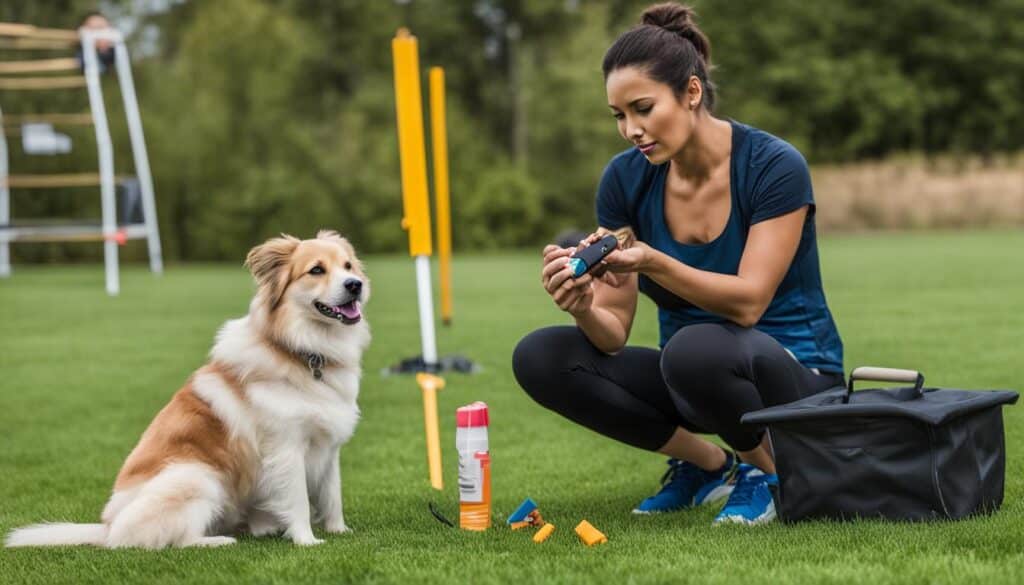Essentials of Training a Service Dog

Service dog training is a vital aspect of empowering individuals with disabilities and providing them with the support they need in their daily lives. Service dogs are highly trained animals that perform specific tasks to assist individuals with disabilities, making them more than just pets. If you are interested in service dog training, it is essential to understand the key principles and requirements of this field.
In this article, we will explore the concept of service dogs, the common breeds used for service dog training, the possibility of training your own service dog, and the benefits of service dog training. Whether you’re considering obtaining a trained service dog or pursuing a DIY training approach, understanding the essentials will help you make informed decisions.
What is a Service Dog?
According to the Americans with Disabilities Act (ADA), a service dog is defined as a dog that is individually trained to perform tasks or work for a person with a disability. These tasks or work must be directly related to the person’s disability and help them participate in major life activities. Service dogs are trained to take specific actions that assist individuals with disabilities, such as guiding the blind, alerting the deaf, providing mobility assistance, and detecting medical issues. They are not considered pets but rather working animals that provide vital support to their handlers.
| Examples of Service Dog Tasks |
|---|
| Guiding the blind: Service dogs can navigate individuals with visual impairments safely, helping them cross roads and avoid obstacles. |
| Alerting the deaf: Hearing dogs can alert their handlers to different sounds, such as doorbells, smoke alarms, or someone calling their name. |
| Providing mobility assistance: Mobility dogs can help individuals with physical disabilities by fetching items, opening doors, or providing support for balance and stability. |
| Detecting medical issues: Some service dogs are trained to detect changes in their handler’s body odor or behavior that indicate a medical issue, such as seizures or low blood sugar. |
Service dogs undergo extensive training to master these disability-related tasks and assist their handlers with major life activities. They are instrumental in enhancing the independence and quality of life for individuals with disabilities.
Common Service Dog Breeds
Service dogs are trained to perform specific tasks based on the needs of individuals with disabilities. These tasks can range from guiding the blind to detecting medical issues. The selection of service dog breeds plays a crucial role in their ability to carry out these tasks effectively.
Some of the most common service dog breeds include:
- Labrador Retrievers
- Golden Retrievers
- German Shepherd Dogs
- Poodles
Labrador Retrievers are known for their friendly and gentle nature, making them excellent service dogs. They are highly trainable and are often used as guide dogs for the blind.
Golden Retrievers are intelligent, trustworthy, and have a calm demeanor, making them well-suited for tasks such as providing emotional support or assisting individuals with mobility impairments.
German Shepherd Dogs are renowned for their intelligence, loyalty, and versatility. They are frequently trained as service dogs for tasks that require physical assistance or search and rescue missions.
Poodles, in particular, are highly regarded for their intelligence and hypoallergenic coats. They come in three sizes – Toy, Miniature, and Standard – offering options for individuals with different needs and living arrangements. Poodles are often trained as service dogs for tasks such as alerting their handlers to specific medical conditions or providing assistance with mobility.
When selecting a service dog breed, factors such as size, temperament, and the ability to perform the required tasks effectively are taken into consideration. Each breed has its unique qualities, and it’s essential to choose a breed that can meet the specific needs of the individual with a disability.

Training Your Own Service Dog
Training your own service dog can be a cost-effective alternative to obtaining a trained service dog from a professional organization. However, it requires careful consideration and assessment of your dog’s suitability for the job.
Factors such as temperament, attention span, and age play a crucial role in determining if your dog is suitable for service dog training. It’s important to understand that not all dogs are temperamentally suited for this type of work. Service dogs need to be calm, friendly, and able to work in various environments.
Before beginning the training process, it is essential to focus on socialization and basic obedience commands. Socialization helps your dog develop good manners and adapt to different situations and environments. Basic obedience commands lay the foundation for more advanced training.
Building a strong bond with your dog is also vital in service dog training. This bond creates trust and establishes a solid working relationship. Regular engagement, positive reinforcement, and spending quality time together will help strengthen the bond between you and your dog.
Once your dog has mastered socialization and basic commands, you can move on to specific task training. This phase focuses on teaching your dog to perform tasks related to your disability. Whether it’s retrieving dropped items, opening doors, or alerting you to specific sounds, the tasks should be tailored to your individual needs.
Keep in mind that service dog training is a complex and time-consuming process. It requires patience, dedication, and consistency. Consistent training sessions, positive reinforcement, and regular practice are essential for success.
Training your own service dog allows for a deeper bond and understanding between you and your dog. However, it’s important to seek guidance from professionals and consider joining local service dog training programs or working with certified trainers. They can provide further expertise and guidance throughout the training process.

By investing time and effort into training your own service dog, you can contribute to the well-being and independence of individuals with disabilities while also forging a lifelong partnership with your four-legged companion.
Conclusion
Service dog training plays a crucial role in empowering individuals with disabilities and providing them with the assistance they need to lead more independent lives. Whether obtained through professional training or through do-it-yourself (DIY) approaches, service dogs offer a wide range of benefits and opportunities for empowerment.
While obtaining a trained service dog can be expensive and time-consuming, DIY training can be a viable option for some individuals. Apart from being cost-effective, DIY training allows for a deeper bond between the handler and the dog. By personally training their service dogs, individuals can develop a strong connection and mutual understanding, creating a relationship built on trust and companionship.
The benefits of service dogs extend beyond the practical tasks they perform. These remarkable animals provide emotional support, companionship, and a sense of security to individuals with disabilities. With their presence, service dogs can help reduce anxiety, boost confidence, and increase social interactions, thereby facilitating a more inclusive and fulfilling life.
By embracing service dog training, individuals with disabilities can experience newfound independence and a higher quality of life. Whether they choose professional training or opt for a DIY approach, the training process empowers both the service dog and its handler. Through dedication, patience, and a mutual commitment to success, service dog training has the power to transform lives, championing the rights and abilities of individuals with disabilities.
FAQ
What is a service dog?
According to the Americans with Disabilities Act (ADA), a service dog is defined as a dog that is individually trained to perform tasks or work for a person with a disability. These tasks or work must be directly related to the person’s disability and help them participate in major life activities.
What tasks do service dogs perform?
Service dogs are trained to take specific actions that assist individuals with disabilities. These tasks can include guiding the blind, alerting the deaf, providing mobility assistance, and detecting medical issues.
What breeds are commonly used as service dogs?
Common service dog breeds include Labrador Retrievers, Golden Retrievers, German Shepherd Dogs, and Poodles. Poodles, in particular, are known for their versatility in training and can be found in Toy, Miniature, and Standard sizes.
Can I train my own service dog?
Training your own service dog can be a cost-effective alternative to obtaining a trained service dog from a professional organization. However, it requires careful consideration and assessment of your dog’s suitability for the job.
How do I train my own service dog?
Training should start with socialization, basic obedience commands, and building a strong bond with your dog. Once the foundational skills are established, specific task training can be introduced based on the handler’s disability and needs.





